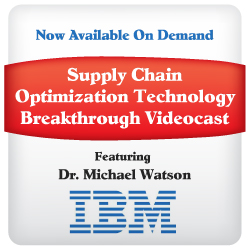 |
October 4, 2012 - Supply Chain Newsletter |
 |
FEATURED SPONSOR - IBM |
 |
|
Optimization 3.0: IBM's Guide to Leveraging the New Wave of Business Featuring Dr. Michael Watson of IBM
|
 |
|
||||||||||||||||||||||||||||||||||||
CSCMP 2012 Full Review and Comment
|
| GILMORE SAYS: |
"I simply wish more academics would deliver the kind of practical and useful research Caplice and too few others in the discipline consistently produce." WHAT DO YOU SAY? |
CSCMP says registration was up slightly this year to 3100 plus. The last quite a few years have been in the range of 3000 plus or minus a few. Can that plateau be taken northward again, after 9/11 and other trends have had a real impact on these kinds of events for almost everyone? (Just think how the once mammoth COMDEX technology show of the 1990s is now simply gone.) I would like to think CSCMP can get back to the 4000 or so level someday soon.
The presentation sessions straddled the second floor to the fifth, but once you took an escalator down or up, the room you needed to get to was usually right there, which doesn't always happen, depending on the venue each year.
There were just 24 tracks this year, an improvement in my view from some past years when the number was climbing I am pretty sure into the 30+ range, making it confusion to find the session you wanted and resulting in too much overlapping session topics between tracks. With the somewhat skinnied down tracks and an especially well laid out and organized conference guide this year, I had no issues with figuring the what and where, as I have sometimes in the past.
I didn't do an official tally, but my sense was that the number of true case study presentations by companies were down a bit from the past few years, but conversely the quality of the presentations by academics, consultants, etc. was up substantially. Out of the 8 sessions I attended (I led one other one) there was only one dud, which shall go nameless. That's a pretty good batting average.
Here are some highlights of what I saw and heard.
Best presentation by a pretty wide margin was led by Raj Subramonian, general manager of Dell's Global Outlet business unit, which takes back returned, damaged, etc. machines, and refurbishes or repairs them, scavenges for parts, etc. for ultimate resale. As you can imagine, this is largely a reverse logistics business, and he said that this success of his division can have a large impact on Dell's financial results for each quarter.
Subramonian described how Dell moved from a traditional outsourcing relationship with GENCO for this work to one based on "vesting outsourcing" principles, a concept developed by Kate Vitasek of Supply Chain Vision and others a few years ago. Kate doesn't much like this characterization, but it is sort of like "gainsharing plus."
The original relationship between Dell and GENCO was a traditional one, based on transaction pricing, a focus on beating down costs, and a strained relationship, in part because like most outsourcing deal when Dell won (lower prices or reduced volumes of returns) GENCO lost.
Ultimately, that model was blown up, replaced with one in which GENCO is significantly compensated on Dell's net margin growth, so that their goals are aligned, and with deep sharing of once hidden information. The result has been strong benefits to the bottom lines of both Dell and GENCO, the latter of which has been able to take out a tremendous amount of cost from the process with more incentive and freedom to innovate.
The story was a good one, but equally so was Subramonian's presentation, which was clearly from the heart, and just had a level of "this is the real deal" to it that is rare to find in these kind of events. Excellent.
The "building the supply chain from the shelf back" concept that we wrote about in May and I believe can be a real inflection point in the consumer goods to retail supply chain was represented in several sessions, including one I led with JDA's Fred Baumann and another by Andre Martin of RedPrairie's Flowcasting Group. Martin did a nice job explaining his approach to "store-level DRP" - this from the man who invented traditional DRP in 1975.
In the session Baumann and I ran, I will here just list some of the great questions we had from the audience as we discussed the opportunity to really leverage store level POS information and drive it all the way back to the factory schedule: Could this lead to still more smaller, more frequent shipments, such that the extra logistics costs outweigh the other benefits? In the end, does forecasting at a store level really deliver that many benefits versus forecasting at the DC and then distributing based on sales and on-hand inventory at each store? Is this concept really only going to be an advantage for large manufacturers and retailers, or is there anything in it for the smaller players?
We addressed these in the presentation, but think there is some more work to do, and I promise we will have some additional thoughts here in Supply Chain Digest soon.
Chris Caplice and MIT colleague Basak Kalkanci presented some excellence research on ocean shipping variability. I simply wish more academics would deliver the kind of practical and useful research Caplice and too few others in the discipline consistently produce.
The pair noted there are a lot of complaints relative to this perceived variability, but relatively little data to support it, including from the companies complaining about it. There is not even any common definition of what such ocean shipping reliability is, they observed, with some focusing on the percent of time the schedule is met within some tolerance level (say plus or minus one or two days) and others on overall consistency (i.e., a tight bell curve of delivery performance).
More on this soon, but bottom line is that using real data from several companies, Caplice and Kalkanci say: there is lot of variability, but the vast majority in port operations on the origin and destination side, not over the water; in general, you can get more inventory benefit by focusing on a reduction of the variability than from reducing average total lead time; there are substantial and not well understood differences in efficiency/time in container handling at the ports between carriers, citing eye opening differences across about two dozen carriers a the port of LA.
I cover many more session and keynote details in the daily video reviews, and we will turn many of these into articles in our On-Target newsletter in coming weeks.
Other quick notes: Ann Drake of DSC Logistics won the Distinguished Service Award. Rick Jackson of The Limited Brands will take over as board chair for 2012-2013. Dal-Tile, Werner, Transplace, Whirlpool and Convermex won the supply chain innovation award for a collaborative transport system that increased cube utilization based on combining loads across companies. I was rooting for Dow Chemical, which has developed an S&OP process for logistics management. Keynoter Boone Pickens says natural gas truck will be deployed on a widescale in the US in 7-8 years, 3-4 if the government gets on board.
Overall, a good conference. The Supply Chain of the Future exhibit that now for I believe the third year is connected to the conference keeps evolving, but to me had a better feel to it this year than the past two, which seemed dominated by AGVs and other material handling systems for distribution. I think the sessions needed more focus on core distribution center stuff and procurement.
Next year in Denver, for CSCMP's 50th anniversary. Hope to see you there.
What were your impressions or takeaways from the CSCMP Conference? Let us know your thoughts at the Feedback button below.
![]()
| View Web/Printable Version of this Page |
|
|
|
YOUR FEEDBACK
We received a few goods letter on our recent First Thoughts column on The Coming Era of Perfect Logistics.
That includes our Feedback of the Week from David Schneider, who says Perfect Logistics is a nice theory, but maybe not much more than that. Gilmore says he will answer that claim, as well as some others, very soon.
Feedback of the Week: On Perfect Logistics
Perfect Logistics across the entire Supply Chain is a "nominal concept," a place that exists in name only. The place does not exist. It is a state of mind, like seeking nirvana, where the journey to enlightenment will still be highly rewarding for those to embark on it. The examples in your article, and where Perfect Logistics will come the closest, is in tightly controlled links. When the process crosses entity lines, between businesses, the concept of perfection will be subject to the financial, technological and cognitive resources of each of the links. Some links will be very strong, others not. The variability of performance will be directly related to the level of commitment to perfection a player's management team makes. Finally, Perfect Logistics runs into the immutable brick wall of the Law of Diminishing Returns. We can get near perfect, but the price is quite high. There is always a point that the cost to get that last degree of perfection is beyond the resources of the component companies. Costs may drop and new technology developed, but imperfect man will still be involved in the equation. Every time you make something foolproof, a new and improved fool arrives. And all of us get to go to work to solve the new and improved problems. David K. Schneider |
||
More on Perfect Logistics:Would you define perfect logistics by the logistics decisions and execution that were taken based on information available at a point of time? Colin Pereira |
||
I think you have extremely well articulated a sense many of us in supply chain are starting to sense, but which we haven't yet given much voice to. Andrew Helferidge |
SUPPLY CHAIN TRIVIA ANSWER
Q:CSCMP CEO Rick Blasgen originally made a name for himself at what food company (later acquired) that has produced a number of supply chain leaders over the years?
A: Nabisco, later acquired by Kraft.
| © SupplyChainDigest™ 2003-2012. All Rights Reserved. SupplyChainDigest PO Box 714 Springboro, Ohio 45066 |
POWERED BY: XDIMENSION
|








